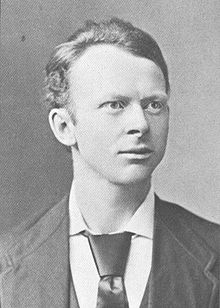Charles Fillmore (mystic)
Charles Sherlock Fillmore ( August 22, 1854 - July 5, 1948 ) was an American mystic and co-founder of the Unity School of Christianity , a religious movement of the New Spirit Movement , with his wife, Myrtle Fillmore .
Life
Charles Fillmore was born on August 22, 1854 on the Chippewa reservation (near St. Cloud , Minnesota). He grew up without his father, who lived separately from the family and was thus primarily shaped by his mother, who came from the Episcopal Church . She often accompanied him and his family until her death in 1931. As an adult, Fillmore traveled west and worked as a railroad freight inspector, mule team driver, inspector and real estate seller. In Denison, Texas he met Mary Caroline Page ("Myrtle"), whom he married five years later and with whom he had three children. You lived in Pueblo , Colorado from 1881 to 1884 , were active in the abstinence movement and had contact with his mother's church and with Methodism .
Through the more intensive occupation with the Neugeist movement from 1886, they dealt in detail with healing methods, but also in general with spiritualism , Christian science and theosophy . As a result, they founded the religious magazine "Modern Thought" together in 1889, primarily influenced by thinkers such as Emma Curtis Hopkins , Eugene B. Weeks and H. Emilie Cady. The Unity churches regard this at the latest as an act of founding their movement. In 1890 they founded the "Society for Silent Help" (later: "Silent Unity"). His wife was appointed director. In the following years they brought out various other magazines, which should give their interpretation of the Neugeist movement and Christianity in principle, expression. They hesitated for a while in founding a new church, but in 1903 the Unity Society of Practical Christianity was founded, to which the Unity School of Christianity was attached in 1914. Charles Fillmore was even more committed than his wife to institutionalizing his movement into its own denomination. In addition to his literary work in which he z. B. significantly influenced the basic "Statement of Faith", he operated several radio broadcasts from 1922 and bought land in Jackson County , Missouri in 1929 , where a farm was then built, and later a whole community.
After Myrtle's death in 1931, he remarried in 1933, namely Cora Dedrick, who, unlike Fillmore's first wife, had little influence on the movement. He then spent a lot of time traveling, especially in California . During this time, responsibility for the movement passed to his three sons, most notably his son Lowell. On July 5, 1948, he died on the Unity farm, which had become the religious center of the movement.
Works
- Christian Healing (1909)
- Talks on Truth (1922)
- The Twelve Powers of Man (1930)
- Metaphysical Bible Dictionary (1931)
- Mysteries of Genesis (1936)
- Prosperity (1936)
- Jesus Christ Heals (1939)
- Teach Us to Pray with Cora Fillmore (1941)
- Mysteries of John (1946)
- Atom-Smashing Power of Mind (1949)
- Keep a True Lent (1953)
- The Revealing Word (1959)
literature
- Dell deChant: Myrtle Fillmore and Charles Sherlock Fillmore. In: American National Biography Online. Oxford University Press, 2000, E-ISBN : 9780198606697.
- Hugh D'Andrade: Charles Fillmore: Herald of the New Age . New York, 1974. (Hagiographic character)
- Neal Vahle: The Spiritual Journey of Charles Fillmore: Discovering the Power Within . West Conshoshocken, Templeton Foundation Press, 2008.
- James Dillet Freeman: The Story of Unity . Lee's Summit, 1954 (characterization similar to Hugh D'Andrade: Charles Fillmore: Herald of the New Age)
- Charles Samuel Braden: Spirits in rebellion: the rise and development of new thought. Southern Methodist University Press, Dallas, 1963. VaS 233-263.
- Jeremy Rapport: Becoming unity: The making of an American religion. ProQuest Dissertations Publishing, Bloomington, 2010, ISBN 978-1-124-35551-1 . VaS 37-56.
- Rudolph F. Verderber: The Rhetoric of Charles Fillmore . Columbia, Missouri, 1962.
Individual evidence
- ↑ Jeremy Rapport: Becoming unity: The making of an American religion. ProQuest Dissertations Publishing, Bloomington, 2010, ISBN 978-1-124-35551-1 . P. 39.
- ↑ a b c Dell deChant: Myrtle Fillmore and Charles Sherlock Fillmore. In: American National Biography Online. Oxford University Press, 2000, E-ISBN : 9780198606697.
- ↑ Jeremy Rapport: Becoming unity: The making of an American religion. ProQuest Dissertations Publishing, Bloomington, 2010, ISBN 978-1-124-35551-1 . Pp. 36, 37.
- ↑ Jeremy Rapport: Becoming unity: The making of an American religion. ProQuest Dissertations Publishing, Bloomington, 2010, ISBN 978-1-124-35551-1 . P. 40.
- ↑ Jeremy Rapport: Becoming unity: The making of an American religion. ProQuest Dissertations Publishing, Bloomington, 2010, ISBN 978-1-124-35551-1 . P. 45.
- ↑ Jeremy Rapport: Becoming unity: The making of an American religion. ProQuest Dissertations Publishing, Bloomington, 2010, ISBN 978-1-124-35551-1 . P. 41.
- ^ Neal Vahle: The Spiritual Journey of Charles Fillmore: Discovering the Power Within . West Conshoshocken, Templeton Foundation Press, 2008. pp. 145-147.
- ↑ Jeremy Rapport: Becoming unity: The making of an American religion. ProQuest Dissertations Publishing, Bloomington, 2010, ISBN 978-1-124-35551-1 . P. 49.
- ^ Charles Samuel Braden: Spirits in rebellion: the rise and development of new thought. Southern Methodist University Press, Dallas, 1963. p. 242.
| personal data | |
|---|---|
| SURNAME | Fillmore, Charles |
| ALTERNATIVE NAMES | Fillmore, Charles Sherlock (full name) |
| BRIEF DESCRIPTION | American mystic and co-founder of the Unity School of Christianity, a religious movement of the New Spirit Movement, with his wife Myrtle Fillmore |
| DATE OF BIRTH | August 22, 1854 |
| DATE OF DEATH | July 5, 1948 |
